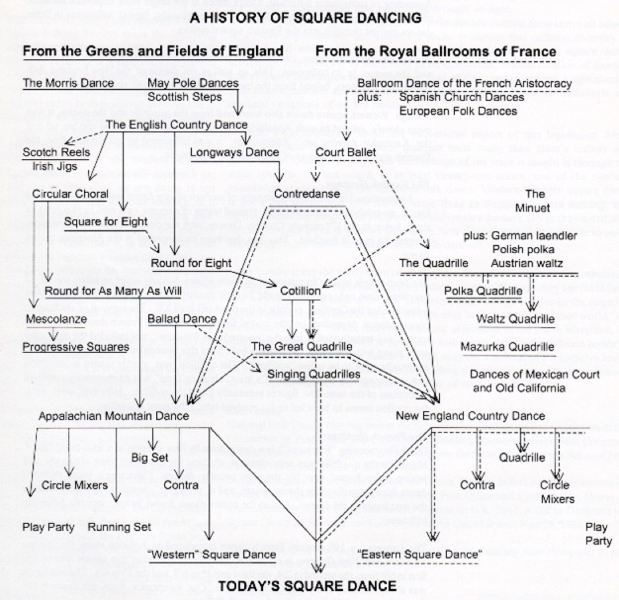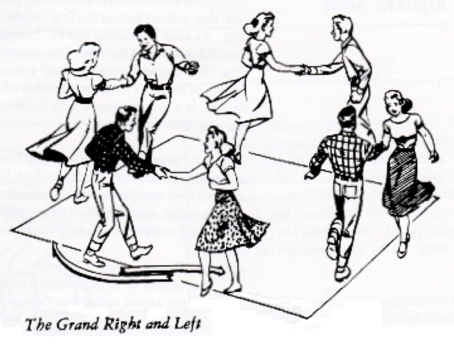
|
Folk Dance Federation of California, South, Inc.
|
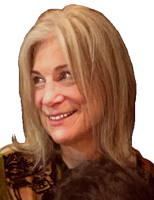
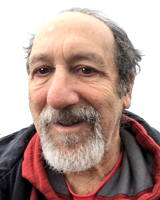
|
CLICK AN IMAGE TO ENLARGE
"Ladies bow and gents bow under
Hug 'em tight and swing like thunder".
"Balance to your places all
And everybody swing."
"Now all join hands and circle left.
Balance to your partners all
And swing that gal across the hall."
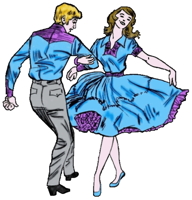 Old time dance on the western prairie, where the towns were few and far between but everyone had a longing to get together in groups. Picture dance at that time, with a small group dancing by lantern light in a hayloft of kitchen, with a single caller-fiddler leading the group. Contrast that to today's square dance, done in a huge ballroom with a modern caller and an orchestra, with hundreds of dancers on the floor.
Old time dance on the western prairie, where the towns were few and far between but everyone had a longing to get together in groups. Picture dance at that time, with a small group dancing by lantern light in a hayloft of kitchen, with a single caller-fiddler leading the group. Contrast that to today's square dance, done in a huge ballroom with a modern caller and an orchestra, with hundreds of dancers on the floor.
Although generally considered American, square dancing stems from a number of European folk dances that preceded it by several hundred years. It began in England and France and came with the settlers to America early in the history of the new world.
As the population spread westward, so also did square dancing, taking different forms as it went. The Appalachian Running Sets migrated to the American Middle West, Oklahoma, and Texas, where they were modified according to local dance traditions. On the other hand, in areas where the Mormons traveled, New England Quadrilles persisted, as did Contras, circles, the Waltz, Polka, and Schottische.
In the middle-west, the dance encountered the Puritanical ethics of the area, and failed to persevere as a dance at all. The Puritans deemed dancing, especially dance to music, sinful. Instead, Play-Parties, where movement was done to singing and clapping of the hands, replaced "dancing." In Texas, too, there were religious barriers to the dance, and so dance calls were devised to "mask" the fact that they were calling "dance" movements. For example, "Meet your honey, pat her on the head, if you can't get biscuit, give her corn bread," translates to "Meet your partner, if you can't do a waist swing, do a two-handed swing."
The uniquely American contribution to Square Dance, the "caller," evolved as a result of these Play Parties. Later in the history of the dance, as the Square Dance patterns came to be more complex and the dances longer, the caller was needed to prompt the dancers' memories of patterns and dance sequences that they had learned. The development of the fiddler-caller was important in the growth of the dance in this country. He was not just an accompanist for the dancers, he was virtually their choreographer. No one knew just what was coming next. Three types of calls have evolved: prompting, singing, and patter calls. Prompting is the usual method: the caller gives directions to the dancers two or more counts before the movements are to be done. In contrast, patter and some singing calls fall with the dance movements. In the latter two, the dancers must know the patterns they are performing before they hear any calls. The calls accompany the movements rather than precede them. Singing calls fall on the beat of the music with the dance movements. Patter is most frequent in the mid-west and the west where the dance rhythms are often done very fast.
A HISTORY OF AMERICAN SQUARE DANCING
Square Dancing in America developed along two separate lines, resulting in Eastern and Western (or Cowboy) square dance. Each borrowed more or less heavily from one or another of the ancestral dance forms of Europe.
Eastern Square Dance was closely linked to New England Country Dances such as the Contra, the Quadrille, and Play-Party dances, all transplants from France and England. According to some dance historians, Contra dance is the single most important ancestor of all the ancestors of the Square Dance. The traditionally formal influences in these dances carried through into the Eastern Square Dances.
During Revolutionary times, the American aristocracy danced the Quadrille, the Contra, and the Minuet in its ballrooms. This, as well as the dances of the New England folk outside the ballroom, helped form the backbone of the American square dance.
Though Western Square Dance also borrowed from the Quadrille and the Contra, it was more closely related to such Appalachian mountain country dances as the Big Set and the Kentucky Running Set. Additionally, it was influenced by movements from the Spanish and Mexican dances of the West and Southwest.
The English Heritage
Unquestionably, the English ancestor of modern Square Dance was the great Morris Dance, an exhibition dance done by trained teams of dancers, six men in two rows of three. Later, in the 17th century, Country Dances, with the circle the preferred formation, became the rage in England. This, too, has been incorporated in the American Square Dance.
The four-couple square formation of more modern Square Dancing is not so easily traced. It has been seen only rarely in the old English Country Dances, and was first included in a dance called the Cotillion, popular in the court of Louis XV. The survival of the English Country Dance depended on the round for eight, which the French discovered. They took it and transformed it into the Contredanse Francaise, and included the square for eight along with the dance. What they built from this material was a Square Dance, that eventually came to be called Cotillion. The Cotillion was strictly square in formation and strictly country as to figure. It's main "claim to fame" was its monotony . . . endless repetitions of the same few figures eventually killed the Cotillion. Over time, however, the Cotillion seems to have led to (or evolved into?) the great Quadrille.
The French Heritage
Quadrille (meaning "foursome") is a dance done by four couples in a four-sided figure. Music for the Quadrille was semi-classical, clothing for the dance more elaborate, and setting more formal than for the older Country Dances. There was a huge, polished dance floor, a platform for the musicians, and a "prompter" (someone to briefly indicate the next figure in the dance). And so the Square Dance found its way into the American ballroom.
The Lancers, a 19th century French dance introduced in America\ among the eastern seaboard and New Orleans, is actually a Quadrille composed of five Square Dances, the first in 6/8 time, the second in 2/4, the third and fourth in 6/8, and the fifth in 4/4. The last figure was always military in style and in march time. Our inheritance from this dance is the Grand Square, which is actually a Lancers fifth figure.
The New England Dance
In contrast to modern Square Dances, the head couple in a Quadrille is number one, the opposite couple two, the couple to the right three, and the couple to the left four. In the first figure of the dance after the introduction, the opposite couples maneuver with each other in a variety of patterns across the set. In the other figures, all four couples move around the square that becomes a circle of dancing action. The pattern of working around the set is a standard form of the Square Dance.
One of the great American adaptations to the dance was the Singing Quadrille. These were Square Dances in the current sense with an opening chorus, a figure repeated two or four times, and a closing chorus. The calls were sung with words, and the music fixed. The most common chorus was then, as now, "allemande left and grand right and left." The French Canadian contribution to the New England dances resulted in the "long swing," now typical of New England Square Dancing.
Though the Quadrille was a major influence in the Eastern square dance, its influence on the Western form of the dance is only tangential. The main stream influence on the Western form of the dance was the Kentucky Running Set.
The Kentucky Running Set
Claimed as one of the oldest and purest dance forms of English origin in this country are the Running Sets of the Southern Appalachians. The Running Sets were, above all, country rather than court dances. These space-gobbling dances, derived from English Country Dances, are composed of a number of patterned figures held together with promenade figures. There are no courtesy movements, no sets, no balances, no courtesy turns. Figures evolve into each other with great speed, and the patterns of the dance seem ancient.
In the Running Set, any number of dancers may join the figure, standing in couples in a circle. The dance can use any of a number of patterns, but the following is typical. After an introductory "circle left," the first couple moves to the second and performs a figure then to the next couple, repeating this figure. As the first couple goes on to the fourth couple, the second couple follows-up, performing the same figure with the third couple, and then follows behind the first couple, repeating this figure with each couple in the ring. This continues until every couple has followed around the ring. The figures themselves bear strong resemblance to the Western square dance figures of today. Though any number of couples can join in, the Running Set is usually danced in a proper square, with the couples being numbered as Square Dance couples are numbered today.
The basic Running Set step is a light, bounding run. All of the movement is in the feet and ankles, that links the dances with English Country Dances as well as Morris Dances. The arms are kept straight and swing naturally with the movements of the body. The Running Sets, in reality, usually consist of anywhere from four to a dozen dances, done consecutively and without breaks in between them.
A Round Square
The Running Set is more truly a round rather than a square eight. The action goes "around" the square rather than "across" it. Those Running Sets that can be done in a Big Set (as many couples as want to join the dance) are more truly Running Sets. Those that cannot be done in the Big Set are more properly termed Square dances, or Quadrilles. The people of the southern Appalachian's did Contra dances in lines and circles. They did not incorporate Quadrilles, however, into their repertoire until relatively recent times.
The Modern Square Dance
Two distinct elements combined to form the modern Square Dance: couple dances and round dances. Round Dances are dances with definite patterns, done not by a single couple but by a group of couples, moving in unison in the same direction, doing the same step, on the same beat of the music. The individual couple has no freedom of movement, only of styling. A couple dance, on the other hand, belongs to the individual couples. It can sweep all over the floor, improvising its own pattern . . . truly a creative dance form. The combination of these two dance forms, doing the patterns of a Quadrille, with the steps of a Waltz or Polka or Mazurka, formed the basis of the modern American Square Dance.
American Square Dances have taken on the color and personality of every decade of American history. As with all truly "folk" dances, the dance form, the music, and the calling of the dance are in constant evolution, responding to the music, social, and ethnic climate of the area in the country in which it is performed.
BIBLIOGRAPHY
- Bol, Lawrence (ed.). The Square Dance. Ford Brothers, Chicago, Illinois, 1950.
- Gowing, Gene. The Square Dancers' Guide. Crown Publishers, New York, New York.
- Jensen, Clayne R. and Jensen, Mary Bee. Square Dancing. Brigham Young University Press, Provo, Utah, 1966.
- Kraus, Richard. Square Dances of Today and How to Teach Them. A.S. Barnes & Company, New York, New York, 1950.
- Putney, Cornelia F. Square Dance U.S.A. Wm. C. Brown Company, Dubuque, Iowa, 1955.
- Shaw, Dorothy and Reese, Kenny. History and Heritage of Modern American Square Dancing. The Internet, on the California Heritage Dancer's Home Page, Last updated on April 23, 1998.
Used with permission of the authors.
Printed in Folk Dance Scene, September 1998.
